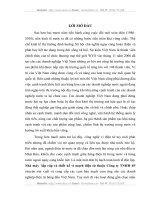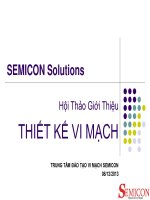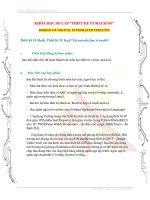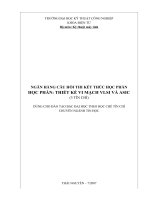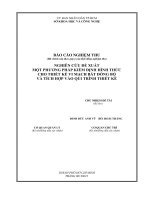Slide thiết kế vi mạch chapter6 fsm
Bạn đang xem bản rút gọn của tài liệu. Xem và tải ngay bản đầy đủ của tài liệu tại đây (1.27 MB, 28 trang )
Digital Design with the Verilog HDL
Chapter 6: Finite State Machine
Dr. Phạm Quốc Cường
Use some Prof. Mike Schulte’s slides ()
Computer Engineering – CSE – HCMUT
CuuDuongThanCong.com
/>
1
Sequential Machine - Definition
• State of a sequential machine contains current information (t)
• Next state (t + 1) depends on the current state (t) and inputs
• The number of states in a sequential machine finite => Finite
State Machine - FSM
Input
Next-state Logic
Next state
(NS)
Feedback of present state
CuuDuongThanCong.com
Present State
(PS)
Memory
Block Diagram of a sequential
machine
2
/>
Synchronous Sequential Machine
• Synchronous State Machine uses clock to
synchronize input states
• Clock is symmetric or asymmetric
• Clock cycle must be larger than time required for
state transaction calculation
• Synchronous FSMs:
– Number of states
– Using clock to control state transaction
3
CuuDuongThanCong.com
/>
FSM Models & Types
• Explicit
– Declares a state register that stores the FSM state
– May not be called “state” – might be a counter!
• Implicit
– Describes state implicitly by using multiple event controls
• Moore
– Outputs depend on state only (synchronous)
• Mealy
– Outputs depend on inputs and state (asynchronous)
– Outputs can also be registered (synchronous)
4
CuuDuongThanCong.com
/>
Mealy machine vs. Moore machine
Block Diagram of a Mealy sequential
machine
Block Diagram of a Moore sequential machine
5
CuuDuongThanCong.com
/>
State Transaction Graph
• Finite state machine can be described:
– State transaction graph, State transaction table
– Time chart
– Abstract state machine
• Finite state machine is a directed graph
– Vertices show states (+outputs if Moore-style machine)
– Edges show transactions from state to state
• Edges’ name
– Mealy machine: input/output
– Moore machine: input
6
CuuDuongThanCong.com
/>
State Diagram
a=0
S0
b=0
a = 1/
Z=1
reset = 1
S1
Y=1
b = 1/
Z=1
S2
• Outputs Y and Z are 0,
unless specified
otherwise.
• We don’t care about
the value of b in S0, or
the value of a in S1, or
either a or b in S2.
7
CuuDuongThanCong.com
/>
State Diagram: Mealy
a=0
b = x/
Y = 0,
Z=0
S0
a=1
b = x/
Y = 0,
Z=1
reset = 1
ab = xx/
YZ = 00
a=x
b = 0/
Y = 1,
Z=0
S1
• Outputs Y and Z are 0,
unless specified
otherwise.
• We don’t care about
the value of b in S0, or
a = x the value of a in S1, or
b = 1/ either a or b in S2.
Y = 1,
S2 Z = 1
8
CuuDuongThanCong.com
/>
State Diagram: Moore
a=0
S0
b=0
a=1
S1
Y=1
Outputs Y and Z are 0,
unless specified otherwise.
If an input isn’t listed for a
transition, we don’t care
about its value for that
transition
b=1
reset = 1
S2
Z=1
9
CuuDuongThanCong.com
/>
Example - Mealy
Next state/Output table
reset
Next state/output
S_0
0/1
State
1/0
1/0
S_1
S_2
0/1
0/0 1/1
S_3
0/0 1/1
S_4
0/0, 1/1
0/1
S_5
S_6
0/1
State transition graph
S_0
S_1
S_2
S_3
S_4
S_5
S_6
input
0
1
S_1/1
S_3/1
S_4/0
S_5/0
S_5/1
S_0/0
S_0/1
S_2/0
S_4/0
S_4/1
S_5/1
S_6/0
S_0/1
-/-
State transition table
10
CuuDuongThanCong.com
/>
Example
1/0
Next State/Output
0/1
S_2
S_0
State
S_1
1/1
S_0
S_1
S_2
0/0
0
S_0/0
Input
S_1/0
0
1
S_1/0
S_0/1
-
S_2/1
S_0/0
Next State/Output
State
1
0
1
S_3/1
1
State transition graph
CuuDuongThanCong.com
Input
0
1
S_1/0
S_2/1
S_1/0
S_3/1
S_0/1
S_3/0
0
S_2/1
S_0
S_1
S_3
S_2
State transition table
/>
11
Constraints
• Each vertex describes only one state
• Each edge describe exactly one transaction from
current state to the next state
• Each vertex has all out-going edges
• At one edge, there is only one out-going edge at one
time
12
CuuDuongThanCong.com
/>
BCD to Excess-3 code Converter
Decimal
digit
BCD
Excess-3
0
0000
0011
1
0001
0100
2
0010
0101
3
0011
0110
4
0100
0111
5
0101
1000
6
0110
1001
7
0111
1010
8
1000
1011
9
1001
1100
CuuDuongThanCong.com
• Excess-3 is selfcomplementing
– 610 = 01102
– 6excess-3 = 01102 + 00112
= 10012
/>
13
Input/output Relation
Bin = 8 (BCD)
Bout = 8 (Excess-3)
1 1 0 1
0 0 0 1
LSB
MSB
Excess-3
Code
converter
MSB
1 0 0 0
0 0 1 1
MSB
clock
1 0 1 1 LSB
Input-output bit stream in a BCD to Excess-3 serial code converter
14
CuuDuongThanCong.com
/>
State Transaction Graph – State Transaction
Table
Next state/Output table
reset
Next state/output
S_0
0/1
State
1/0
input
1/0
S_1
S_2
S_0
S_1
S_2
S_3
S_4
S_5
S_6
0/1
0/0 1/1
S_3
0/0 1/1
S_4
0/0, 1/1
0/1
S_5
S_6
0/1
State transition graph (Mealy type FSM)
0
1
S_1/1
S_3/1
S_4/0
S_5/0
S_5/1
S_0/0
S_0/1
S_2/0
S_4/0
S_4/1
S_5/1
S_6/0
S_0/1
-/-
State transition table (Mealy type FSM)
15
CuuDuongThanCong.com
/>
State Encoding
• States are stored by FFs
Encoded Next state/output table
• 7 states, using 3 FFs
State
Next state
q2q1q0
q2 + q1 + q0+
State assignment
Input
q2q1q0
State
000
S_0
S_0
001
S_1
010
S_6
011
S_4
100
101
S_2
110
S_5
111
S_3
CuuDuongThanCong.com
Output
Input
0
1
0
1
000
001
101
1
0
S_1
001
111
011
1
0
S_2
101
011
011
0
1
S_3
111
110
110
0
1
S_4
011
110
010
1
0
S_5
110
000
000
0
1
S_6
010
000
-
1
-
100
/>
-
-
-
-
16
Simplify State Transaction Function
q0Bin
00
01
11
10
00
1
1
1
1
01
0
X
0
11
0
0
10
X
X
q2q1
q0Bin
00
01
11
10
00
0
0
1
1
0
01
0
X
1
1
0
0
11
0
0
1
1
1
1
10
X
X
1
1
q2q1
q0 + = q 1 ’
q0Bin
q1 + = q 0
00
01
11
10
00
0
1
0
1
01
0
X
0
11
0
0
10
X
X
q2q1
00
01
11
10
00
1
0
0
1
1
01
1
X
0
1
1
1
11
0
1
1
0
0
0
10
X
X
1
0
q2+ = q1’q0’Bin + q2’q0Bin’ + q2q1q0
CuuDuongThanCong.com
q0Bin
q2q1
Bout = q1’Bin’ + q2Bin
/>
17
Implementing BCD to Excess-3 Converter
18
CuuDuongThanCong.com
/>
FSM Example: Serial-Line Code Converter
• 3 signals:
– Clock
– Handshaking signal
– Data
• Well-known encoding algorithms:
– NRZ
– NRZI: if input is 1, the previous output value is inversed while 0 input
keeps output unchanged
– RZ: if input is 1, output is 1 during the first half cycle and 0 during the
second half cycle while 0 input produces 0 output
– Manchester: if input is 0, output is 0 during the first half cycle and 1
during the second half cycle while 1 input produces 1 output during
the first half and 0 output during the second half
19
CuuDuongThanCong.com
/>
Serial Encoding Examples
• Clock_2’s frequency is double clock_1’s frequency to implement the NRZI,
RZ, and Manchester encoding algorithms
20
CuuDuongThanCong.com
/>
Mealy FSM for Serial Encoding
• The Manchester algorithm
– Waiting state (S_0)
– Just receiving 1 state (S_2)
– Just receiving 0 state (S_1)
1/0
Next State/Output
0/1
S_2
S_0
State
S_1
1/1
Input
0
1
S_1/0
S_0/1
-
S_2/1
S_0/0
0/0
State
Next State
q1q0
q1+q0+
S_0
S_1
S_2
Output
Input
Output
q0
0
1
0
1
q1
0
1
S_0
00
01
10
0
1
0
S_0
S_1
S_1
01
00
00
1
-
1
S_2
--
10
00
00
-
0
S_2
CuuDuongThanCong.com
21
/>
Implementing the Mealy FSM
Bin
0
1
00
0
1
01
0
11
10
q1q0
Bin
1
00
0
1
0
01
1
1
-
-
11
-
-
0
0
10
0
0
1
00
1
0
0
01
0
-
-
11
0
0
10
q1+ = q1’ q0’Bin
CuuDuongThanCong.com
q1q0
Bin
0
0
q0+ = q1’ q0’Bin
q1q0
Bout = q1’( q0 + Bin)
/>
22
Moore FSM for Serial Encoding
•
The Manchester Algorithm
–
–
–
–
S_0: starting/second half of the cycle receiving 1, the output is 0
S_1: first half of the cycle receiving 0, the output is 0
S_2: second half of the cycle receiving 0, the output is 1
S_3: first half of the cycle receiving 1, the output is 1
State
Input
1
S_0
S_1
S_3
S_2
0
S_0/0
Next State/Output
0
1
S_1/0
S_2/1
S_1/0
S_3/1
S_0/1
S_3/0
State
Next State
q1q0
q1+q0+
0
1
S_3/1
1
Output
Input
CuuDuongThanCong.com
0
1
S_0
00
01
11
0
S_1
01
10
_
0
S_3
11
_
00
1
11
/>
S_2
10
23
01
1
S_1/0
0
S_2/1
Implementing the Moore FSM
Bin
0
1
00
0
1
01
1
X
11
-
0
10
0
1
q1q0
Bin
0
1
00
0
0
01
1
1
q1
q1+ = q1’ q0’Bin
Bin
0
1
00
1
1
01
0
-
11
-
0
10
1
1
q1q0
CuuDuongThanCong.com
/>
24
Simplify Equivalent States
• Two states are equivalent:
– Output and the next states
are the same in all inputs (c1)
– Can be combined together
without any changed
behavior (c2)
• Reducing two equivalent
states reduces hardware
cost
• Each FSM has one and only
one simplest equivalent
FSM
Next state
Output
Input
Input
State
0
1
0
1
S_0
S_1
S_2
S_3
S_4
S_5
S_6
S_7
S_6
S_1
S_2
S_7
S_7
S_7
S_0
S_4
S_3
S_6
S_4/S_
5
S_3
S_2
S_2
S_1
S_3
0
0
0
0
0
0
0
0
0
1
1
1
0
0
0
0
Equivalents states
New state
25
CuuDuongThanCong.com
/>
